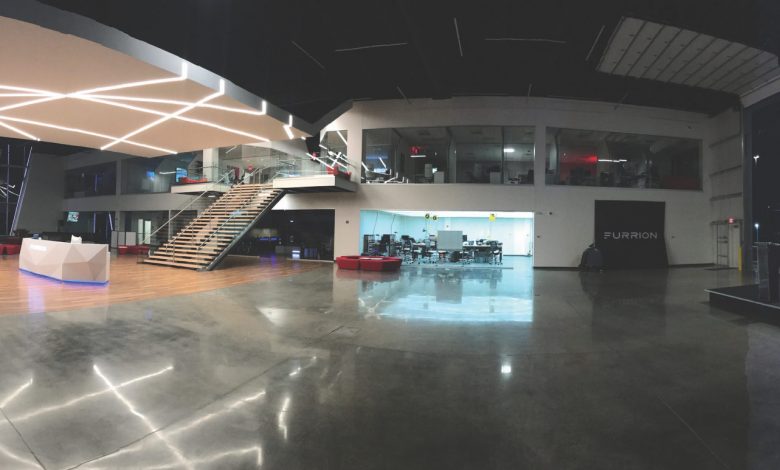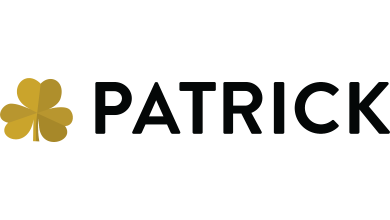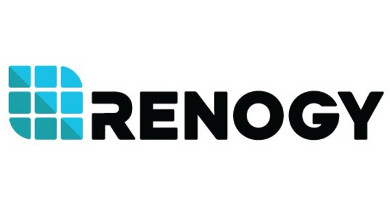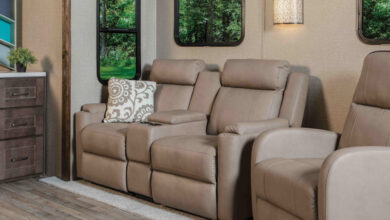Next Phase for Furrion

Over the relatively short course of its corporate life, Furrion has made great strides in bringing the contents of the average RV into the 21st century.
The company has made a name for itself designing high-end audiovisual electronics, video surveillance cameras, kitchen appliances and energy equipment.
But, all along, the company did more than just import these goods. Designers and engineers hired by Furrion were working not only to come up with the next big idea, but also working on ways to integrate their technology into the vehicles that were their target market.
This not only included RVs, but also yachts, hotels and homes.
Early examples of what is possible are regularly on display at Furrion’s Innovation Center & Institute of Technology in Elkhart, Ind., as well as at shows such as the RVIA National RV Trade Show in Louisville, Ky. Furrion has developed a prototype fifth wheel and Class A motorhome as well as a semi truck affectionately known as Hercules to show off its products.
Initially, the prototype vehicles just showed off walls full of products, but now the interiors have been redesigned to showcase what is possible in the RV of the near future.
And Furrion is anxious to collaborate with other manufacturers to bring that hip future to the consumers sooner rather than later.
“Having a strong foothold in the RV manufacturing capital of the world puts together a lot of resources so we can collaborate with manufacturers on design,” says Matt Fidler, Furrion’s co-founder and chief marketing officer. “It puts us in a position to engage other people and help them create designs that integrate technology and electronic products in the vehicles.”
Getting Their Attention
The power of Furrion’s concept vehicles can’t be overstated.
Even in the middle of a busy trade show floor, when the fifth wheel model first appeared in Louisville, it made people stop and stare. And only part of that was due to the hot model sitting in an inflatable hot tub on the back deck of the vehicle.
Then, at 2016’s show, Furrion’s motorhome, complete with a helicopter landing pad and hot tub, caught even more attention.
Now, the Hercules truck, built to tow the fifth wheel across the country, is gaining even more attention. Fidler says the company was approached by the crews that make the “Transformers” movies to possibly include the truck in an upcoming movie.
Furrion also has had some of its products show up in the HBO series “Silicon Valley”.
“Hollywood is quite excited about us,” Fidler says.
Apparently, so are some of Furrion’s partners and competitors.
When Furrion first debuted its fifth wheel, it was the only company exhibiting from a vehicle. And special arrangements had to be made with event planning staff to get that vehicle in the supplier show area. During the 2017 Louisville show, at least three other suppliers had some variation of travel trailers or fifth wheels displaying their products.
It’s that kind of copying that lets Fidler and his brother, CEO Aaron Fidler, know they are on the right track when it comes to getting their corporate message out.
“In RV manufacturing, we also see a lot of opportunity,” Matt Fidler says. “With the concept models we’ve designed, we plan to take them to rallies and shows to show off our ability to design products and also to present the lifestyle to those who aren’t familiar with the possibilities and just how cool it can be.”
But Furrion doesn’t stop with just the RV industry.
“We’re building a luxury 78-foot yacht, which is a brand-new project that we were approached to design for someone,” Fidler says. “We’re also getting into hotels as well. We’ve been approached to design a hotel and integrate our tech and our products into that hotel room.”
With the success of the prototype models, Furrion is ready to move ahead with plans to be able to design an entire RV if a manufacturing partner is looking to go that far. But mostly, the company wants to collaborate by designing things such as end caps and cockpit dashes to integrate as many relevant electronic products as possible into the design of the vehicle.
“We wanted to have our design division of the business collaborate with the OEMs on a deeper level,” Fidler says. “As we advance technology in RVs, the OEMs will require a significant level of customization. Our goal with Furrion design is to help integrate these products. For example, parking sensors, pedestrian sensors and observation cameras can be designed into end caps. Or our digital electronics can be engineered to fit motorized dashes and create a better user experience for the driver.”
The Future is Now
Fidler says that as technology changes, there needs to be more customization in the design of an RV – especially in the driver’s area – in order to take advantage of that technology.
Currently, more manufacturers are looking at technology such as driver-assist to keep a vehicle in its lane. Other upgrades include backup cameras and side cameras that require monitors in the dash area. And eventually, driverless technology could make its way into RVs.
Fidler points to the automotive industry as an example of how current design and manufacturing isn’t up to the task of integrating the latest technology into the cockpit.
“When you look at dashes in typical RVs, there isn’t enough space for big touchscreen displays or digital gauge clusters,” he says. “That’s why it needs to have the level of customization. A lot of the RV manufacturers would prefer us to work with their designers, but we are being approached for us to do the design and manufacture for these components.”
Fidler says that as technology continues to advance, it is important for Furrion designers to be able to collaborate with manufacturers on a deeper level to make sure those advances are incorporated into the design of the vehicle so that they are not only efficient, but also intuitive for a driver to monitor.
“It’s all about supporting the manufacturers with complementary design teams to help them design new products such as end caps and cockpit dashes,” Fidler says. “We will work with them to incorporate our products.”
A new product that Furrion is introducing to OEMs and the aftermarket shows the possibilities of integrated design.
The Vision S camera system is designed to be both a backup-camera system and a security system.
The cameras – with built-in microphones – can be installed into Furrion marker lights on the rear of the vehicle. Or the manufacturer can install the marker lights without the system and allow the dealership to sell the Vision S as an upgrade. It can be installed on any current RV.
Either way, the system can be designed into the end cap.
Vision S connects to monitors via 2.4 gigahertz digital wireless signal. In addition to rear cameras, a separate camera can be mounted above an entry door for security. The monitor can be installed on the windshield of the RV or tow vehicle, but also can be removed from the mount and taken into the bedroom, for example, if the system is being used for security at night. It has motion sensors that will wake up the inside monitor to alert anyone inside if something is going on outside.
It also includes audio, so if the driver is getting assistance backing up, the helper can talk into the microphones and can be heard inside the cockpit or tow vehicle.
Keeping Up with Tech
Fidler says Furrion isn’t changing its core business. He says design and engineering have been a core part of the company since its inception. This is just the next phase.
He says the company employs more than 80 designers, engineers and technologists, whose jobs are not only to build on the latest technology but also to help integrate it into the markets Furrion serves.
The company has doubled its business each of the past seven years, according to Fidler, and is looking for ways to stay on top as developments such as auto-driving applications begin to enter the market.
“We’re starting to look into and develop our resources into driverless technology and how to integrate that with our electronics,” he says.
But regardless of what comes next, Furrion’s expectations are to grow with the RV industry and help keep RVing relevant to a younger generation that has grown up with smart technology.
“We don’t do anything slowly,” Fidler says. “We’re hard and fast and we want to keep on growing. We’re hungry and we’re having a lot of fun.”


